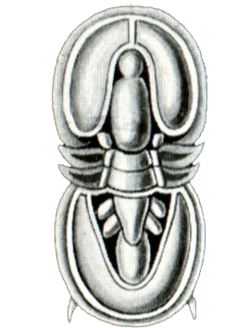User:Abyssal/Portal:Ediacaran
IntroductionSelected article on the Ediacaran world and its legacies
The Ediacara biota consisted of enigmatic tubular and frond-shaped, mostly sessile organisms that lived during the Ediacaran Period (ca. 635–542 Ma). Trace fossils of these organisms have been found worldwide, and represent the earliest known complex multicellular organisms. The Ediacara biota radiated in an event called the Avalon explosion, 575 million years ago, after the Earth had thawed from the Cryogenian period's extensive glaciation. The biota largely disappeared contemporaneously with the rapid increase in biodiversity known as the Cambrian explosion. Most of the currently existing body plans of animals first appeared in the fossil record of the Cambrian rather than the Ediacaran. For macroorganisms, the Cambrian biota appears to have completely replaced the organisms that populated the Ediacaran fossil record, although relationships are still a matter of debate.
Multiple hypotheses exist to explain the disappearance of this biota, including preservation bias, a changing environment, the advent of predators and competition from other life-forms. Breandán MacGabhann argues that the concept of "Ediacara Biota" is artificial and arbitrary as it can not be defined geographically, stratigraphically, taphonomically nor biologically. He points out that 8 particular fossils or groups of fossils considered "Ediacaran" have 5 taphonomic modes (preservation styles), occur in 3 geological periods, and have no phylogenetic meaning as a whole. (see more...) Selected article on the Ediacaran in human science, culture and economics
Paleontology or palaeontology (/ˌpeɪliɒnˈtɒlədʒi, ˌpæli-, -ən-/) is the scientific study of prehistoric life. It includes the study of fossils to determine organisms' evolution and interactions with each other and their environments (their paleoecology). As a "historical science" it attempts to explain causes rather than conduct experiments to observe effects. Paleontological observations have been documented as far back as the 5th century BC. The science became established in the 18th century as a result of Georges Cuvier's work on comparative anatomy, and developed rapidly in the 19th century. The term itself originates from Greek: παλαιός (palaios) meaning "old, ancient," ὄν, ὀντ- (on, ont-), meaning "being, creature" and λόγος (logos), meaning "speech, thought, study".
Paleontology lies on the border between biology and geology. It now uses techniques drawn from a wide range of sciences, including biochemistry, mathematics and engineering. Use of all these techniques has enabled paleontologists to discover much of the evolutionary history of life, almost all the way back to when Earth became capable of supporting life, about 3,800 million years ago. As knowledge has increased, paleontology has developed specialized sub-divisions, some of which focus on different types of fossil organisms while others study ecology and environmental history, such as ancient climates. Body fossils and trace fossils are the principal types of evidence about ancient life, and geochemical evidence has helped to decipher the evolution of life before there were organisms large enough to leave fossils. (see more...) Selected image
Did you know?
GeochronologySeries - Terreneuvian - Cambrian Series 2 - Cambrian Series 3 - Furongian Geography - Pannotia - Baltica - Gondwanaland - Laurentia - Siberia Fossil sites - Walcott Quarry Researchers - Stephen Jay Gould - Simon Conway Morris - Charles Doolittle Walcott Quality ContentFeatured Cambrian articles - None SubcategoriesRelated contentAssociated WikimediaThe following Wikimedia Foundation sister projects provide more on this subject:
|























